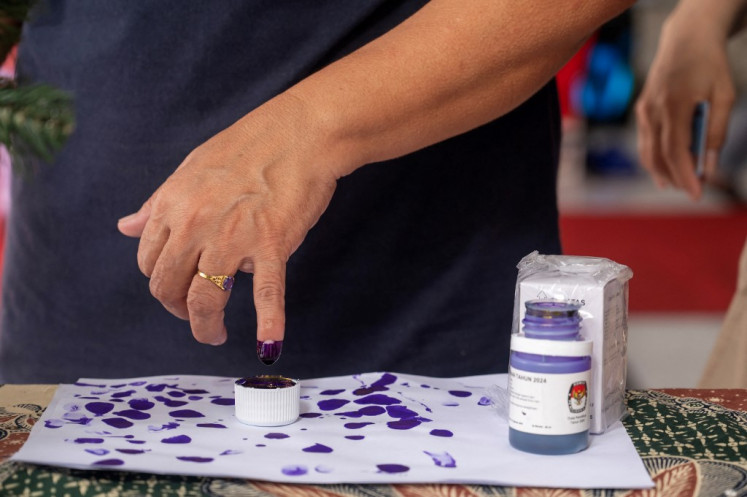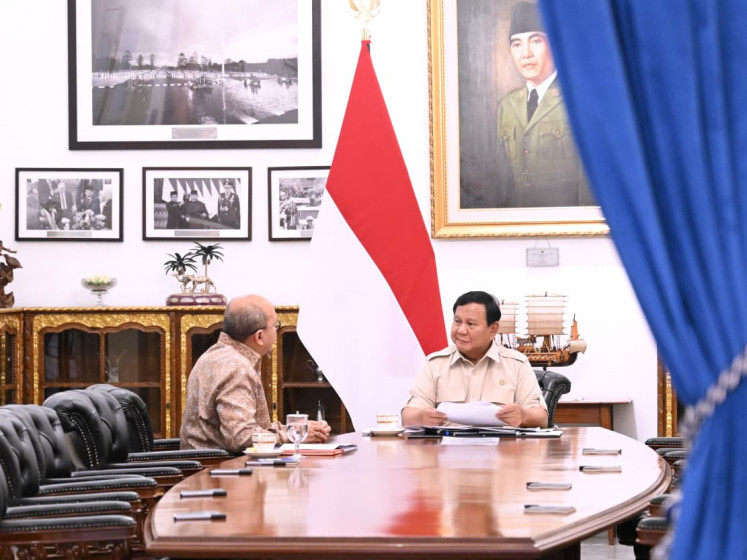Popular Reads
Top Results
Can't find what you're looking for?
View all search resultsPopular Reads
Top Results
Can't find what you're looking for?
View all search resultsAn encounter with history in Tangerang
Carved and decorated: The Benteng Heritage Museum features a gorgeous central courtyard, an original element of the building
Change text size
Gift Premium Articles
to Anyone
C
span class="caption" style="width: 223px;">Carved and decorated: The Benteng Heritage Museum features a gorgeous central courtyard, an original element of the building. JP/Deanna Ramsay
The bustling lanes of Tangerang’s Pasar Lama yield many joys — the fruits and vegetables for sale piled high on sidewalk stands, the wafting scent of incense from the 18th-century Boen Tek Bio Temple and the many crumbling, antiquated buildings lining the market’s snaking alleys.
Yet amid the flurry of activity in the area sits another treasure, the still-in-the-making Benteng Heritage Museum.
The brainchild of Udaya Halim, a Tangerang local who grew up right across the street, the museum lies in a restored 19th-century structure that was likely home to both a Chinese association and generations of families.
Now, the building has been painstakingly and beautifully restored and filled with antiques Udaya has collected over the years from Chinese communities and collectors from Melaka to Perth.
Final touches are still being made to the outside of the museum, which sits, obscured, smack in the middle of the Pasar Lama. Udaya plans to open on the auspicious Nov. 11, 2011, or 11/11/11.
Story in stone: Many original details are preserved within the building, including a set of reliefs depicting the story of a Chinese warlord. JP/Deanna Ramsay
A stroll through the gorgeous interior takes one back in time. Engraved wooden doorframes, paper lanterns, shards of Chinese ceramics and the tiny slippers of women with bound feet decorate the many rooms, reminders of times long, long past.
Udaya said the building had been trashed before he purchased it two years ago. After clearing out the garbage, he discovered various original touches remained, including Chinese characters engraved over the doors to the left and right of the entryway — a traditional element of Chinese buildings — and the wood floor on the second story. Udaya said he only had to polish the wood to return it to its original brilliance.
Another unique detail also survives — what may be the piéce de résistance — elegantly carved reliefs along the second story’s central courtyard depicting the story of a famous Chinese warlord.
Udaya said those carvings caused him to question whether the building had originally been constructed as a home as he had thought, for Chinese houses do not usually contain such intricately carved designs. The building also lies directly at the back of the Boen Tek Bio Temple, which led Udaya to conclude that the current Benteng Heritage Museum was previously associated with the temple and used as a meeting hall for Chinese residents.
He said he created the museum to commemorate the Chinese community in Tangerang. According to a Sundanese history, the first Chinese in the area arrived in 1407, originally destined for what is now Jakarta. Now, Tangerang is home to a distinctive community of Chinese known as the Cina Benteng (Chinese of the Fort), who are believed to be the descendants of those original travelers and are the source of the museum’s name.
The results of Udaya’s own research into the Chinese in Southeast Asia are incorporated in the museum’s displays. He begins by gesturing toward an image of the Chinese navigator Cheng Ho, who famously voyaged throughout the region in the 15th century. Udaya uses those long-ago journeys as the starting point for the presentations of Chinese items from throughout Asia, with those from Tangerang expertly incorporated into the broader story of overseas Chinese.
He gestures toward a stone tablet etched with Chinese characters that he salvaged from a site along the Cisadane River where many Chinese homes used to lie. The epigraph says, “In 1873 … 81 Chinese donated 18,756 ringgit to build 30 roads,” marking an important gift to Tangerang’s early infrastructure.
Old black-and-white photos decorate the walls, images of old Tangerang including images of Udaya’s own family and of the Pasar Lama in the 1950s, with one of the building’s street showing that next door had been a dentist’s office. The sign that used to hang there now sits in the museum.
Directly across the way had been a photography studio, and amid Udaya’s collection is an antique camera the man who owned the studio used for portraits. Udaya explained that the man had been mute, and demonstrates how the photographer had used a bell to inform those being photographed to prepare for the camera.
As these many stories filled with subtle details resonate throughout the site, one begins to realize that the Benteng Heritage Museum is preserving a very special slice of history, one that weaves stories of the neighborhood with grand historic events like the voyages of Cheng Ho.
Udaya is quick to say, “I am not an antique collector. The value to me is history.” He has met with overseas Chinese groups from Melaka, Penang and Singapore, and said he considers the museum part of that network, a network of people striving to preserve the many histories of the Chinese in the region.
Musical accompaniment: The Nanfeng Nusantara band, framed in an ornate wooden door panel, performs Chinese Indonesian songs at a museum event. JP/Deanna Ramsay
And, those histories go beyond material objects. In February of this year, Udaya held a special event that focused on that rich slew of culture that resulted after Chinese arrivals to the Indonesian islands mixed with locals. A veritable feast of food was provided to the accompaniment of the enchanting Nanfeng Nusantara band, one of its singers clad in a 50-year-old kebaya. A dragon dance was later performed in the small lane in front, a dance Udaya emphasized was no longer strictly Chinese – it was a style of dragon dance that only exists in Indonesia.
Udaya said part of what he was aiming for in developing the site was to “clear up what is Cina Benteng”, to debunk stereotypes about the Chinese in Indonesia. Part of that effort is presenting and preserving the food, music and dance, those ephemeral elements of culture that, unfortunately, can too easily be lost or forgotten.
On display: Figures of various Chinese gods and goddesses decorate an altar, part of the museum’s lessons about Tangerang’s Chinese. JP/Deanna Ramsay
The Benteng Heritage Museum is certainly the first and only of its kind in Indonesia, a painstakingly and lovingly produced space that remembers the long history of Chinese interactions in the Indonesian islands and that also preserves many lovely, local Tangerang histories.
The place holds additional significance for Udaya as it is also a family affair, having already become a part of his heritage to be passed down. He prods his son on the subject over lunch, asking him, “What will you do if someone wants to buy the building?”
Later at the museum, Udaya shows off a mint 1910 gramophone. He turns the crank and places a weathered record on the turntable. The muffled, crackling strains of a song likely recorded a century ago echo throughout the room.
Yes, history is certainly more than mere artifacts.













